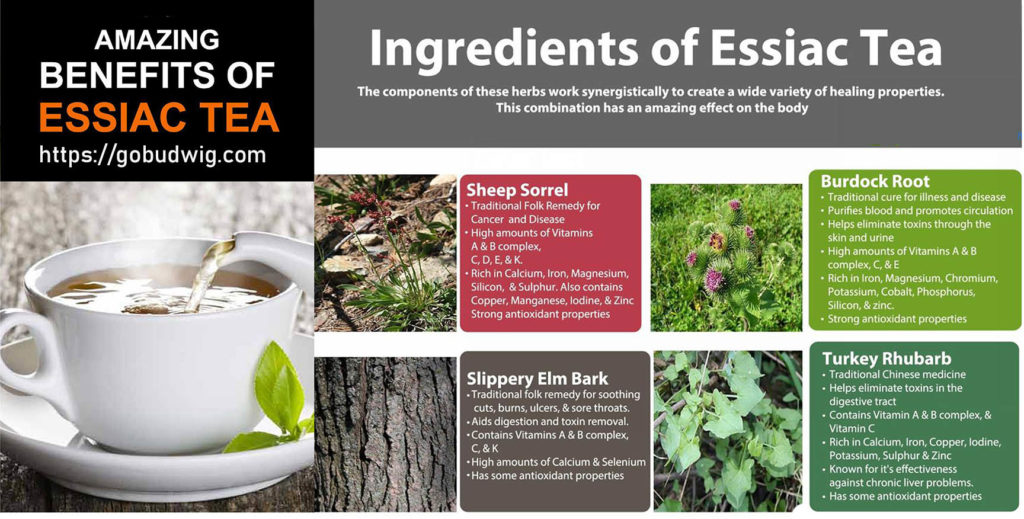On a lucky day in 1922, Canadian nurse Rene Caisse in northern Ontario, Canada saw an elderly lady taking bath in a river; she had some scar tissue on one of her entire breast. When asked this lady told her that she developed cancer before 30 years and an Ojibway Indian herbalist told her to make a tea out of certain herbs and drink it to heal her cancer. She had no recurrence of cancer to that day. Rene noted down this miracle formula.
In the ensuing years Nurse Caisse refined and perfected the original formula. She tested various herbal combinations on laboratory mice and on human cancer patients. Some versions of Essiac had eight ingredients. The added ingredients are supposed to enhance the product’s effectiveness and improve its taste. But she eventually used four herbs to make this tea: burdock root, sheep sorrel (whole herb including the roots), slippery elm and Turkey rhubarb. She called the formula Essiac, which is her surname spelled backwards.
In 1924 she decided to test the tea on her aunt who had stomach cancer and was given about six months to live. Her aunt lived for another 21 years, without any cancer.
Rene Caisse later gave the tea to her 72-year old mother who was diagnosed with inoperable cancer of the liver, with only days to live. Her mother recovered and lived cancer free for another 18 years.
Eventually, she became so involved with her research that she focused all her time on the treatment of patients. Doctors all over Canada were sending their patients to her cancer clinic for the treatment. From 1934 to 1942 she successfully treated thousands of terminally ill cancer patients in her clinic in Bracebridge, Ontario. During this time many, many doctors, surgeons, and scientist visited her clinic, read case histories, and examined patients (Caisse).
Essiac Formula

The Recipe
1 – Using a stainless steel pot and lid, boil 15 g of herb mix in 1.5 liters of pure, unchlorinated water on high heat for ten minutes.
2 – Turn off heat, cover with lid and allow herbs to steep for 12 hours.
3 – Heat up tea to steaming, but not boiling. Allow herbs to settle for a couple minutes.
4 – Strain off hot liquid into sterilized bottles or canning jars. The remaining pulp can be used for healing poultices.
5 – Refrigerate tea. For long-term storage use the boiling water bath canning method and store in a cool, dark and dry place.
Dosage suggestions
Recommended essiac tea dosage is 30 ml of tea per day, taken preferably before sleep. Mix the tea with 60 ml of warm or cold water. Double the dose of tea and water after a week’s time. Do not eat or drink anything (except water) one hour before to one hour after taking Essiac. The taste of the tea is somewhat bitter and bothers some people. Most people get used to the taste over time. Be aware that chemo and radio can lessen the effects of essiac tea. In this case you can increase the dose. Administer for at least 6 months after your test results have returned to normal.
Benefits of Essiac
Helps to cleanse the blood
Normalize the enzymes
Promotes cellular repair, and aids effective assimilation and elimination
Regulates cholesterol levels by transforming sugar into energy
Makes bones, joints, ligaments, and lungs strong and less vulnerable
Nourishes and stimulates the brain and nervous system
Expels mucus clearing the lungs
Helps eliminate heavy metal toxins in tissues (aluminum, mercury poisoning)
Purifies the blood
Increases red blood cell production
Protects the body against radiation damage
Helps destroy parasites in the digestive tract
Prevents the buildup of fatty deposits in heart kidney and liver
Assists the liver in producing lecithin, which forms the myelin sheath that encapsulates the nerve fibers.
Essiac Tea for Diabetes
“March 2013 my wife was told she had cancer of the colon that had spread to her liver which showed 8 tumors. Her tumor marker for cancer was over 2200. She started chemo immediately and I started her on Essiac Tea. The PET scan taken in October 2013 showed the cancer in the colon was not showing up on the scan any more. Doctor said it was a miracle!!! Only one tumor was found on the liver, 7 are gone. Her cancer marker went from 2200 to 2.5 which is in the normal range. Doctor said in the beginning they can’t cure her cancer, just may be prolong her life. Her doctor was amazed at her progress, so we are going to continue the Essiac.”
Submitted by opn4bzns via Youtube – Nov. 17th 2013.
Testimonial
Burdock (Arctium lappa)
Health Benefits
Rich in potassium, iron, manganese, magnesium, zinc, calcium, selenium and phosphorus.
Vitamins folic acid, riboflavin, pyridoxine, niacin, Vit-E and Vit-C
Non-starch polysaccharides such as Inulin (is Prebiotic and helps reduce blood-sugar level, body-weight, and cholesterol levels in the blood), glucoside-lappin, mucilage
Diuretic, diaphoretic and a blood purifying agent.
Cancer – stops metastasis
Used in measles, arthritis, tonsillitis, throat pain, gout, rheumatism, snake bites, rabies, ulcers, dandruff, hair loss, acne, eczema, psoriasis and viruses like the common cold
Sheep Sorrel (Rumex acetosella)
Health Benefits
Rich in Vitamin A, B complex, C, D, E, and K
Anti-cancer, Anti-inflammatory, Antibacterial agent, Antioxidant, Diuretic, and immune booster.
Sheep sorrel has been used for cancer, fever, sinusitis, generalized inflammation and scurvy
Slippery Elm (Ulmus rubra)
Health Benefits
Mucilage – sore throats and suppresses coughs, laxative, and binds toxins.
Fatty acids, tannins, and sterols – antioxidant and anti-inflammatory.
Used in Cancer, Skin wounds and burns, Sore throat, Cough, Gastro esophageal Reflux/Heartburn, ulcerative colitis and Crohn’s disease, Irritable Bowel Syndrome, Diarrhea, Psoriasis and other skin conditions (Essiac Facts.com).
Turkish Rhubarb (Rheum palmatum)
Health Benefits
Mucilage- sore throats and suppresses coughs, laxative, and binds toxins.
Fatty acids, tannins, and sterols – antioxidant and anti-inflammatory.
Used in Cancer, Skin wounds and burns, Sore throat, Cough, Gastro esophageal Reflux/Heartburn, ulcerative colitis and Crohn’s disease, Irritable Bowel Syndrome, Diarrhea, Psoriasis and other skin conditions







Where do you get these herbs to make the tea?
Starwest Botanicals Organic Essiac Tea, 1 Pound
Buy from amazon